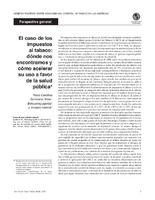The case of tobacco taxation: where we are and how to accelerate its use for public health
| dc.contributor.author | Sandoval, Rosa Carolina | |
| dc.contributor.author | Belausteguigoitia, Itziar | |
| dc.contributor.author | Hennis, Anselm | |
| dc.date.accessioned | 2016 | |
| dc.date.available | 2016 | |
| dc.date.issued | 2016 | |
| dc.identifier.citation | Sandoval RC, Belausteguigoitia I and Hennis A. The case of tobacco taxation: where we are and how to accelerate its use for public health. Rev Panam Salud Publica. 2016;40(4):200–1. | en_US |
| dc.identifier.uri | https://iris.paho.org/handle/10665.2/31299 | |
| dc.description.abstract | Raising tobacco taxes is one of the core strategies outlined in the World Health Organization (WHO) Framework Convention on Tobacco Control (FCTC) to reduce the demand for tobacco products (1). According to the Guidelines for the Implementation of Article 6 of the FCTC, effective tobacco taxes (understood as taxes that raise the price of tobacco relative to other goods and services), can serve three purposes: (i) reduce tobacco consumption, (ii) generate government revenue, and (iii) reduce health inequalities (2). Best practices for tobacco tax policy developed by the WHO recommend the adoption of a relatively simple tax system that applies equivalent taxes to all tobacco products, with the total tax share representing more than 75% of the retail sale price, and the portion of that corresponding to excise taxes representing at least 70% of the final retail price.(3) Despite taxation being considered as the most costeffective intervention to reduce tobacco use, it remains largely underutilized within the Region of the Americas. No country has reached the 70% excise tax share threshold recommended in the WHO Technical Manual on Tobacco Tax Administration, and only one country (Chile) has reached the highest category of achievement described in the WHO Report on the Tobacco Epidemic, marked by a threshold of at least a 75% share of total tobacco taxes in the retail price of the most widely sold brand of cigarettes.(3–5) Meanwhile, there are 13 countries in the second highest category of achievement, 14 countries in the third highest category of achievement, and five countries in the lowest category of achievement, where the respective thresholds are a 51-75%, 26–50%, and 0–25% share of total tobacco taxes in the retail price of the most widely sold brand. Nevertheless there has been some progress in the 10 years since the entry into force of the FCTC. Twenty-one Member States have increased the total tax share of the price of 20 cigarettes of the most widely sold brand, but only four countries (El Salvador, Nicaragua, Panama, and Saint Lucia) increased taxes to a level that allowed advancement from one tax share category to the next as defined above. At the same time the total tax has effectively declined in 12 countries. Two countries (Haiti and Cuba) lack adequate information that would allow a similar comparison... | en_US |
| dc.language.iso | en | es_ES |
| dc.relation.ispartofseries | Rev Panam Salud Publica;40(3), oct. 2016 | es_ES |
| dc.subject | Tobacco Use Cessation | es_ES |
| dc.subject | Public Health Policy | en_US |
| dc.subject | Taxation of the Tobacco-Derived Products | en_US |
| dc.title | The case of tobacco taxation: where we are and how to accelerate its use for public health | en_US |
| dc.title.alternative | El caso de los impuestos al tabaco: dónde nos encontramos y cómo acelerar su uso a favor de la salud pública | es_ES |
| dc.type | Journal articles | en_US |
| dc.rights.holder | Pan American Health Organization | en_US |
| paho.articletype | Editorials | es_ES |
| paho.source.centercode | US1.1 | es_ES |
Files in this item
This item appears in the following Collection(s)
-
Pan American Journal of Public Health
Revista Panamericana de Salud Pública





